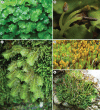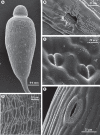Major transitions in the evolution of early land plants: a bryological perspective
- PMID: 22356739
- PMCID: PMC3310499
- DOI: 10.1093/aob/mcs017
Major transitions in the evolution of early land plants: a bryological perspective
Abstract
Background Molecular phylogeny has resolved the liverworts as the earliest-divergent clade of land plants and mosses as the sister group to hornworts plus tracheophytes, with alternative topologies resolving the hornworts as sister to mosses plus tracheophytes less well supported. The tracheophytes plus fossil plants putatively lacking lignified vascular tissue form the polysporangiophyte clade. Scope This paper reviews phylogenetic, developmental, anatomical, genetic and paleontological data with the aim of reconstructing the succession of events that shaped major land plant lineages. Conclusions Fundamental land plant characters primarily evolved in the bryophyte grade, and hence the key to a better understanding of the early evolution of land plants is in bryophytes. The last common ancestor of land plants was probably a leafless axial gametophyte bearing simple unisporangiate sporophytes. Water-conducting tissue, if present, was restricted to the gametophyte and presumably consisted of perforate cells similar to those in the early-divergent bryophytes Haplomitrium and Takakia. Stomata were a sporophyte innovation with the possible ancestral functions of producing a transpiration-driven flow of water and solutes from the parental gametophyte and facilitating spore separation before release. Stomata in mosses, hornworts and polysporangiophytes are viewed as homologous, and hence these three lineages are collectively referred to as the 'stomatophytes'. An indeterminate sporophyte body (the sporophyte shoot) developing from an apical meristem was the key innovation in polysporangiophytes. Poikilohydry is the ancestral condition in land plants; homoiohydry evolved in the sporophyte of polysporangiophytes. Fungal symbiotic associations ancestral to modern arbuscular mycorrhizas evolved in the gametophytic generation before the separation of major present-living lineages. Hydroids are imperforate water-conducting cells specific to advanced mosses. Xylem vascular cells in polysporangiophytes arose either from perforate cells or de novo. Food-conducting cells were a very early innovation in land plant evolution. The inferences presented here await testing by molecular genetics.
Figures











References
-
- Albert VA. Shoot apical meristems and floral patterning: an evolutionary perspective. Trends in Plant Science. 1999;4:84–86.
-
- Alpert P. The limits and frontiers of desiccation-tolerant life. Integrative and Comparative Biology. 2005;45:685–695. - PubMed
-
- Asakawa Y. Chemical constituents of the Bryophytes. In: Herz W, Kirby GW, Moore RE, Steglich W, editors. Progress in the chemistry of organic natural products. Vol. 65. Vienna: Springer; 1995. pp. 1–562. - PubMed
-
- Bargel H, Koch K, Cerman Z, Neinhuis C. Structure-function relationships of the plant cuticle and cuticular waxes – a smart material? Functional Plant Biology. 2006;33:893–910. - PubMed
-
- Barnett JR. Plasmodesmata and pit development in secondary xylem elements. Planta. 1982;155:251–260. - PubMed

